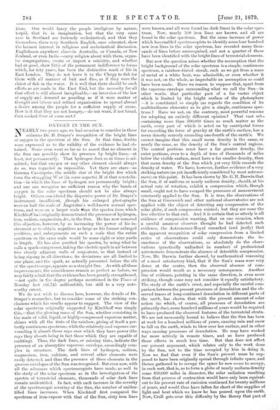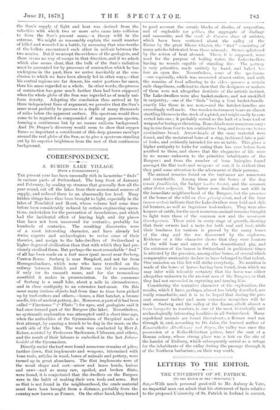OXYGEN IN THE SUN.
NEARLY two years ago, we had occasion to consider in these columns Dr. H. Draper's recognition of the bright lines of oxygen in the spectrum of the Sun. At that time, doubts were expressed as to the validity of the evidence he had ob- tained. Some even went so far as to assert that no element in the Sun can possibly show its presence by bright lines,—at least, not permanently. That hydrogen does so at times ad- mitted ; but that oxygen or any other element should always do so, was regarded as impossible. Yet there are stars—as Gamma Cassiopeia?, the middle star of the bright five which form the straggling W or (in some aspects) M of that constella- tion—in which the lines of hydrogen are permanently bright ; and one can recognise no sufficient reason why the bands of oxygen in the solar spectrum should not be also always bright. Others considered the dispersive power of Dr. Draper's instrument insufficient, othough his enlarged photographs were on half the scale of Angstrom's well-known normal spec- trum, and were on a larger scale than the spectra from which Kirchhoff had originally demonstrated the presence of hydrogen, iron, sodium, magnesium, &c., in the Sun. He has now removed this objection, however, by so increasing the power of his in- strument as to obtain negatives as large as his former enlarged positives, and enlargements on such a scale that the entire spectrum on the same scale would be some eight or nine yards in length. He has also purified his spectra, by using what he calls a spark-compressor, taking the electric spark in air between two closely adjacent walls of soap-stone, so that instead of being zig-zag in all directions, its deviations are all limited to one plane, and the spark, as actually presented before the slit of the spectroscope, appears as a straight line. As with all these improvements, the coincidences remain as perfect as before, we may fairly admit that the evidence has been greatly strengthened, —not quite in the degree perhaps mentioned in the Times of Monday last (68,725 millionfold), but still to a very note- worthy extent.
We do not wish to discuss here, however, the details of Dr. Draper's researches, but to consider some of the striking con- clusions which his results appear to suggest. The view of the solar spectrum originally suggested by Kirchhoff was simply this,—that the glowing mass of the Sun, whether consisting in the main of solid, liquid, or highly-compressed vaporous matter, shines with all the tints of the rainbow, giving of itself a per- fectly continuous spectrum; while the relatively cool vapours sur- rounding it absorb those rays over which they have power (the rays they absorb being in fact those which they are capable of emitting). Thus, the dark lines, or missing tints, indicate the presence of an absorptive vaporous envelope, exceedingly com- plex in structure. The dark lines of hydrogen, sodium, magnesium, iron, calcium, and several other elements were easily detected, and thus the presence of these elements in the gaseous envelopes of the Sun was recognised. But even now, with all the advances which spectroscopists have made, as well in the study of the solar spectrum as in the investigation of the spectra of terrestrial elements, thousands of solar dark lines remain unidentified. In fact, with each increase in the severity of the spectroscopic scrutiny of the Sun, the number of uniden- tified lines increases. When Kirchhoff first compared the spectrum of iron-vapour with that of the Sun, sixty iron lines were known, and all were found (as dark lines) in the solar spec- trum. Now, nearly 500 iron lines are known, and all are found in the solar spectrum. But the same increase of power which has enabled spectroscopists to identify some four hundred new iron lines in the solar spectrum, has revealed many thou- sands of lines before unrecognised, and not a quarter of these have been identified with the bright lines of terrestrial elements.
But now the question arises whether the assumption that the bright background of the solar spectrum is a simple, continuous spectrum, a rainbow-tinted streak, such as we get from a mass of metal at a white heat, was admissible, or even whether it it was not, on the whole, as improbable an assumption as could have been made. Have we reason to suppose that, apart from the vaporous envelope surrounding what we call the Sun—in other words, that particular part of a far vaster object which is limited by the bright surface of the photosphere —it is constituted so simply (as regards the condition of its multitudinous elements) as to give a simple, continuous spec- trum ? Have we not, on the contrary, most powerful reasons for adopting an entirely different opinion ? That vast orb, containing more than 300,000 times as much matter as the earth, every part of which is acted on by centripetal forces far exceeding the force of gravity at the earth's surface, has a mean density scarcely exceeding one-fourth of the earth's. We cannot imagine that this small mean density is the same, or nearly the same, as the density of the Sun's central regions. The central portions must have a far greater density, the outer portions, even to a depth of tens of thousands of miles below the visible surface, must have a far smaller density, than that mean density of the Sun which yet very little exceeds the density of water. We have, however, further evidence of a very striking nature (as yet insufficiently considered by most astrono- mers) on this point. It has been shown by Mr. G. H. Darwin that the Sun, if of uniform or nearly uniform density, should, at his actual rate of rotation, exhibit a compression which, though small, ought not to have escaped the processes of measurement constantly applied to the Sun. It is true, the observations of the Sun at Greenwich and other national observatories are not applied with the object of detecting any compression of the solar globe, if such compression existed; but they are none the less effective to that end. And it is certain that so utterly is all evidence of compression wanting, that on one occasion, when a careful amateur observer thought he had detected such evidence, the Astronomer-Royal remarked (and justly) that the apparent recognition of solar compression from a limited series of observations could only demonstrate the in- exactness of the observations, so absolutely do the obser- vations (practically unlimited in number) of professional astronomers demonstrate the absence of detectible compression. Now, Mr. Darwin further showed, by mathematical reasoning of a most satisfactory kind, that if the Sun's mass were very dense at the centre, then the observed absence of com- pression would result as a necessary consequence. Another line of evidence, pointing in the same direction, is even more striking, though some may not consider it equally satisfactory. The study of the earth's crust, and especially the careful com- parison between the present processes of denudation and the ob- served traces of long-continued denudation in different parts of the earth, has shown that with the present amount of solar action (to which, of course, all processes of denudation are primarily due), some hundred millions of years would be required to have produced the observed features of the terrestrial strata. We are not necessarily bound to believe that the Sun has been at work for a hundred millions of years, causing rain and snow to fall on the earth, winds to blow over her surface, and in other ways causing processes of denudation. He may have worked far more actively in remote times, and so have produced those effects in much less time. But that does not affect our present argument, which relates only to the work done by the Sun, not to the time occupied by him in doing it. Now we find that even if the Sun's present mass be sup- posed to have been originally spread through infinite space, and thence gathered in to occupy the space he now seems to occupy, in such sort, that is, as to form a globe of nearly uniform density some 850,000 miles in diameter, the solar radiation resulting from that process of contraction would have only been equival- ent to his present rate of emission continued for twenty millions of years, and would thus have fallen far short of the supplies of light and heat which we know he has poured upon the earth. Now, Croll gets over this difficulty by the theory that part of
the Sun's supply of light and heat was derived from the velocities with which two or more orbs came into collision to form the Sun's present mass,—a theory wild in the extreme. We might as reasonably explain the small number of killed and wounded in a battle, by assuming that nine-tenths of the bullets encountered each other in mid-air between the two armies. But if we accept the evidence of the geologists, and there seems no way of escape in that direction, and if we admit which also seems clear, that the bulk of the Sun's radiation must be accounted for by processes of contraction which he has undergone in the past, then we arrive inevitably at the con- clusion to which we have been already led in other ways,—that his central regions are far denser, his outer portions far rarer, than his mass regarded as a whole. In other words, the process of contraction has gone much farther than had been supposed when the whole globe of the Sun was regarded as of nearly uni- form density. Adopting the conclusion thus anived at by three independent lines of argument, we perceive that the Sun's mass must probably be gaseous to a depth of many thousands of miles below the apparent surface. His spectrum would thus come to be regarded as compounded of many gaseous spectra, forming a continuous but by no means uniform background. And Dr. Draper's discovery would seem to show that oxygen forms so important a constituent of this deep gaseous envelope around the real globe of the Sun, as to give a spectrum standing out by its superior brightness from the rest of that continuous background.



































 Previous page
Previous page